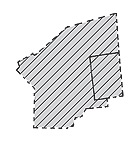The Mamluk Period, 1250-1517 CE
|

|
With the fall of the Ayyubid dynasty in Egypt, the Mamluk period began and lasted until the Ottoman conquest in 1517 CE. During this period Jerusalem did not play an important role in the politics of the empire because of its location far away from the system of main roads. Nevertheless the city fulfilled an important function from a religious standpoint and the character of Jerusalem changed from that of a cosmopolitan city to that of a religious Muslim city. Many magnificent religious and charity buildings were constructed in the city and were characterized by their special style, decorations and inscriptions, some of which exist to this day.
Architectural elements from Crusader buildings were dismantled for use in the Mamluk structures. Many scholars agree that for most of the Mamluk period Jerusalem remained an open city, with the exception of the Citadel which was reinforced in 1310 CE. This stronghold was probably fortified against domestic enemies rather than external threats. Others claim it is unreasonable to assume that Jerusalem remained an open city during the entire Mamluk period, not during the reign of Baybars and certainly not during that of Sultan Qa'it Bay who built extensively in the city. This opinion is based on various contemporary sources that state the city was surrounded by a wall (which was probably the continued use of the ancient walls).
Finds:
The Citadel was reinforced. There are inscriptions that attest to the construction of the Citadel in 1310 CE.
Historical Sources:
The most important written source of the period is the book by the judge Mahir a-Din al-Almi (1456-1521) which tells the history of Jerusalem and Hebron.
Remarks:
Lions Gate probably dates to the time of Baybars and its stones include reliefs of leopards which were later used by the Ottomans.
The question of the walled city is discussed at length in M. Ben-Dov 1983, pp. 71-72.
|
|

|
| The presumed line of the city wall in the Mamluk period |

|
| A woodcutting from 1493 depicting the destruction of Jerusalem |
The Jewish National and University Library and the Hebrew University of Jerusalem, Department of Geography, Historic Cities Research Project
|
|















